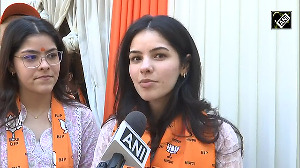With 1 million subscriptions from its "Non-Stop Mobile" scheme in just 45 days, Tata Teleservices has increased its market share in the mobile wireless space to 4.5 per cent in November from a minuscule 1.5 per a year ago.
The share is still paltry compared with peers like Bharti Televentures, which commands nearly 22 per cent market share, or BSNL which has 19 per cent, but the company's "insaan phone leta hai tarakki karne ke liye" campaign, a brainchild of McCann Erickson's Regional Creative Director Prasoon Joshi, appears to have worked.
"The advertisement was a perfect blend of aspirational value and the product's low cost, and played an important role in the product's success," says Joshi.
Tata Teleservices is confident that the pace of subscription will continue. Says Darryl Green, CEO Tata Teleservices, "By March 2006, we should have (mobile plus fixed wireless) 10 million subscribers and by FY07 at least 20 million. That is more than three times the current base of 6.5 million."
That means Tata Teleservices must garner 13.5 million customers in 16 months, a run rate of 840,000 subscribers a month. Net additions of cellular subscribers in November were 729,000, nearly 21 per cent of net additions.
"Assuming the current run rate of 3 million a month, Tata Teleservices must get a 20-25 per cent share incrementally of the cellular space. That's a tall order," a telecom analyst pointed out. By March 2006, the company will roll out its network in 2,500 cities from 1,700 now.
As for the balance sheet, Green believes that a subscription level of 30 million (of which 25 million wireless) will make the company positive on the profit before tax front.
The combined losses for Tata Teleservices and Tata Tele Maharashtra Limited are estimated at Rs 2,000 crore (Rs 20 billion).
The "Non-stop" scheme, which allows a customer to use the mobile service and receive calls for two years without buying a recharge voucher, has targeted the lower end of the market with the "micro pre-paid" voucher.
This time around, Tata Teleservices has not subsidised the handsets, so the customer has to fork out Rs 2,499 for the instrument and Rs 50 for the first voucher. And interestingly, 70 per cent of these subscibers are first-time mobile phone users.
"We are the first to have given the customer freedom not to recharge for two years. So, we have captured that mindspace and even if our competitors imitate us, the first mover advantage will give us sustainability," Green said.
Telecom consultants don't believe that's necessarily true.'They may have the advantage for about six months but beyond that others can take over, ' says an industry watcher. What's more, the company says it's making money. Explains Green, 'It's wrong to believe that low ARPUs (Average Revenue Per User) are not profitable. There are users who are willing to pay a higher tariff for the convenience of buying smaller recharge vouchers.'
He adds that the operating magins for one customer with an (ARPU) of Rs 1000 and that for 10 customers with an ARPU of Rs 100 each, are not very different, because the cost for servicing 10 customers is not very much higher.
Besides, pre-paid tariffs are in any case higher than post-paids -- for instance, the tariff for the Rs 50 voucher is Rs 3 per minute. Also, there is money to be made from incoming terminating revenues. Says Green, "Low callers are not necessarily low receivers and so we're seeing reasonably good ARPUs."
A profitability comparison done by a foreign brokerage shows that the EBITDA (Earnings before Interest Depreciation and Tax) margins for a micro-prepaid scheme are actually much higher that those for a pre-paid scheme.
The margins for a voucher of say, Rs 330 would be 36 per cent compared with 54 per cent for a voucher of say Rs 200. That's thanks to a higher net realisation per minute (both in and out) of Rs 2.05 for the Rs 200 voucher and Rs 1.53 for the Rs 300 voucher.
In fact, the net realisation per outgoing minute for the lower denomination voucher is Rs 8.13 versus Rs 3.35 for the higher denomination voucher. While Green will not share numbers, he believes there is a case for business at even small ARPUs, especially for TTSL,since the company still has some spare capacity and additional capex is negligible.
However, telecom analysts say that the company's EBITDA margins will be under pressure at lower ARPUs once it starts spending on capex again. "Managing costs will be a challenge' he says.
According to Green, what will also be crucial to sustain subscriptions is the availability of a range of handsets, since customers invariably want more choice. TTSL will be launching at least eight low-cost models next year. And none of these will be subsidised. Analsysts believe that prices of CDMA handsets will have to be brought down further to match those of GSM handsets.







 © 2025
© 2025